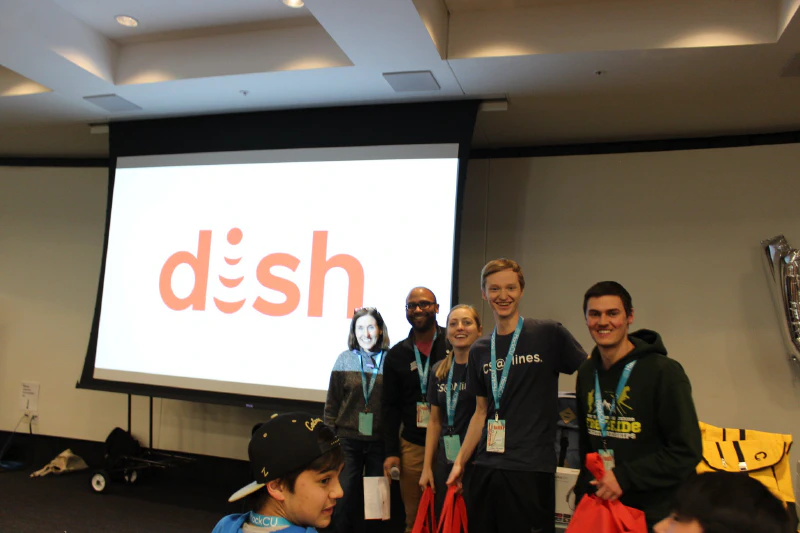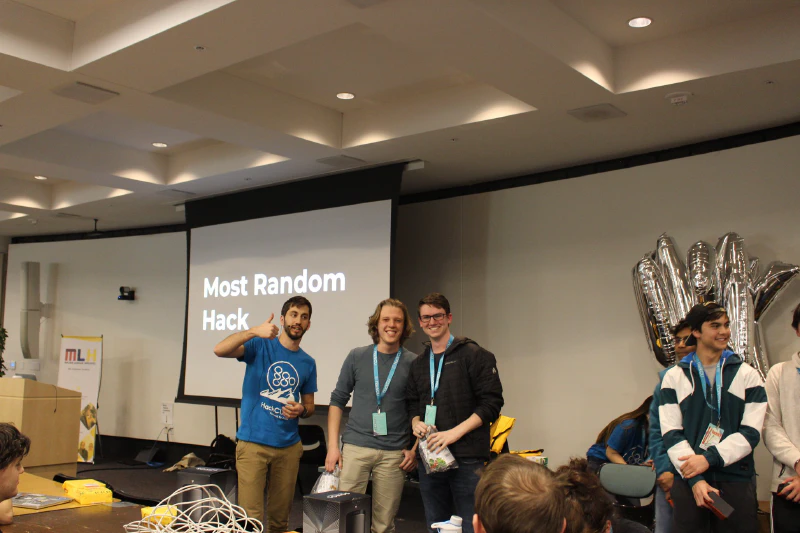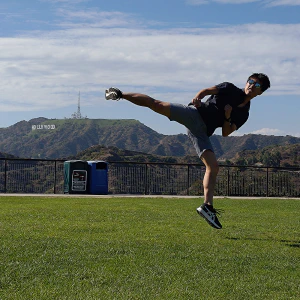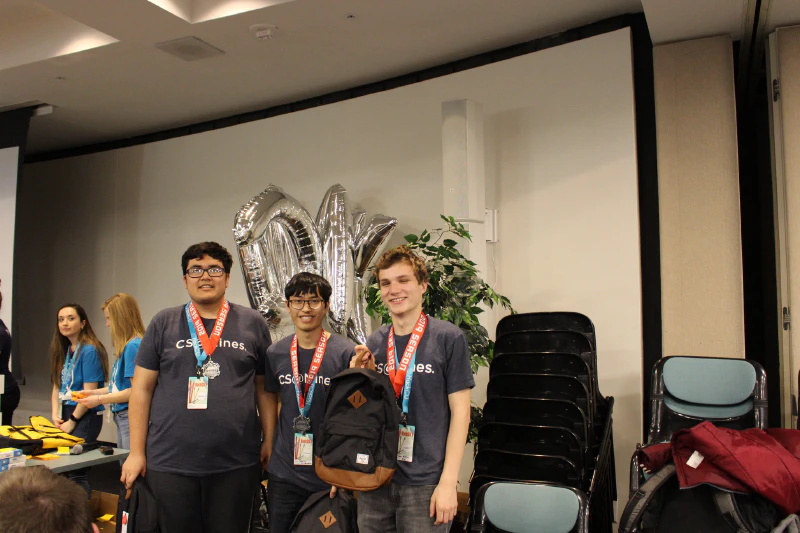Posted
on
in
Hackathons
• 1799 words
• 9 minute read
Tags:
HackCU, Prize, WiFi
A couple of weekends ago (Feb. 23-24), nearly 30 Mines students (myself included), attended the HackCU hackathon at CU Boulder.
Since the hackathon was so close and since I was driving up to the hackathon, I decided to bring all of my electronics. I brought my desktop, a monitor, my mechanical keyboard, my ThinkPad, my MacBook Pro, my iPad, a Raspberry Pi, and a variety of other assorted cables and electronics. It was a good thing I did, too, since we ended up using all of them during the hackathon.
For this hackathon, I decided to make a team of me and 3 freshmen. My team consisted of Ben Perkins, Nick Jarmusz, Jesus Nuñez, and myself. Ben had been to a few hackathons during high school, and also attended MHacks this fall. This was Nick’s and Jesus’s first time at a hackathon.
All of the Mines people headed out from Mines at 8:00, or at least that was the plan. In actuality only one member of my team was at the meeting point at 8:00. (The other cars heading up had similar luck getting everyone there on time.) At around 8:15 Jesus and I decided to go to the Trads to check to make sure that Ben was awake. He wasn’t. Nick was also late, but he was at least awake. We left at about 8:50.
The drive up was pretty uneventful and we got there at around 9:30, which was perfectly fine since things didn’t even start until 10:30.
We wandered around looking at the vendors’ booths. Then there was an opening ceremony. After that, we got some lunch (the catered food was really good). Then, they were setting up tables, and not allowing people to claim tables. They didn’t do a good job patrolling, and a bunch of other people started camping out. The Mines people wanted to be generally in the same area, so we were rather annoyed. After complaining, we were able to get our tables.
Like last year’s HackCU, they had way too few power strips, but we were able to manage initially (I actually ended up going to Target to buy a power strip at one point during the hackathon). We set up our computers and talked about what we were going to make, and grabbed some lunch.
We had a couple of ideas initially, mainly related to machine learning or VR (I had brought my desktop with its Nvidia GTX 2070 for that reason). We didn’t really have any ideas that were cool until we thought of using WiFi ping signals to identify users’ locations and then cluster devices using ML to make estimates of how many people are in a space and their general movement patterns.
We started by doing some academic research into work done by Stanford and others in using WiFi to track users’ movements throughout a space. Things we researched included:
- ArrayTrack: Fine-Grained Indoor Location System
- Waitz
- SpotFi: Decimeter Level Localization Using WiFi
- Accurate, Low-Energy Trajectory Mapping for Mobile Devices
Having done this research, we were not only confident that our idea was viable, but also that we would be able to point to the research in case our system was terribly inaccurate. If it did, in fact, give terrible accuracy, we could say that we didn’t have time to integrate all of the research in this space and that with more time and better equipment, we would be able to greatly increase accuracy. (It’s always good to have a scapegoat…)
We determined that we would have to build the following main components for a minimal proof-of-concept.
WiFi Ping Capture: We needed some way of capturing WiFi pings made by devices. This system also needed to give us a way to determine the signal strength of each of the pings.
Signal Analysis: We needed a way to use the signal strength to create estimate the distance from the detection node to the device.
Trilateration: We needed a way to determine the position of each device given distances from at least three capture nodes. (Trilateration is where you use distances, rather than angles to calculate positions. Triangulation, which is what is often used incorrectly to refer to trilateration, uses angles to calculate distances.)
Visualization: We needed a user interface to show the locations of devices relative to the three detection nodes.
If we had time, we wanted to extend it further by adding a few more components:
Device Clustering: Often, people have many devices. In these cases, we wanted to be able to cluster devices together using data analytics so that we could track numbers of people rather than numbers of devices.
User Tracking: We wanted to be able to track a given person’s motions through the space with a high degree of accuracy.
At this point, we split off and started working on various components of the system. Nick and I got set up for TensorFlow (in case we needed it later on, it takes forever to get running). Ben started trying to figure out how to make a Raspberry Pi into a hotspot that can capture pings, and Jesus did a ton of research on how to use signal strength to measure distance from antenna to device, and trilaterate based on three of those distance measurements.
By about 18:00, I started working on the trilateration logic. By 22:00, that was basically completed. In the meantime, Ben and Jesus kept working like a champ and determined that the Raspberry Pi was not going to cut it since the WiFi adapters did not have the ability to be set it up in monitor mode which is what we needed for it to receive pings. They began working on using laptops to act as our detection nodes instead. Nick worked on getting a server set up to accept data from the ping collection nodes.
I took a nap for a couple of hours, and then at around midnight, I started working on the frontend for displaying the location of all of the devices we were tracking. I hate frontend dev. I just threw together some Bootstrap (the base of which I stole from a previous project, as always). By about 04:00, most of the frontend was complete, the backend of the web server needed to be hooked up though, and that didn’t come until later that morning. I went to bed for a couple of hours, and then when I got up, I worked with Nick to hook up the frontend. We completed that around 10:00, but we still were having trouble figuring out how to calculate distance from signal strength. (Nick and Jesus had worked on it for a while earlier in the morning but hadn’t quite cracked it yet. I don’t remember exactly when as I was asleep/working on other stuff.) We only had two hours left, so we all worked on it together to figure out what equations were necessary to make the trilateration work correctly. We finished about half an hour before noon, and took the next few minutes to clean up and prepare for demos.
Nick had to go back to school because of a band concert (I think), so he headed out before demos. Jesus, Ben, and I held down the fort.
We demoed to about 8 judges (many of whom were sponsor judges, since we entered into a lot of sponsor prizes). It was a lot more than some of the teams around us, not sure why that was (maybe they wanted a second look at some of the projects?).
I was quite tired at that point, and it was difficult to stay enthusiastic about the project while demoing, but we made it work.
Eventually, the representative from MLH came over to our table and told us that we were in the top 5 and would be demoing our project in front of everyone! That was extremely cool, I’d never made it to the finals of an MLH hackathon. At this point, we were in a sort of pinch. My laptop was tied down being a fake WiFi access point, and my desktop was running the web application. All of our other laptops were likewise utilized. So, I pulled out my Mac. I was running Ubuntu on my MacBook Pro because of needing it to do ROS development for Human Centered Robotics, so we used my MacBook to hook up to the projector for the demo (good thing I brought everything…).
We demoed second. It went pretty well. Demos can always go better, but it worked out fine. After all of the demos, we waited around and listened to all of the sponsor prizes. Easton, Kristin, and Zach won Second Place in the Dish Network Challenge (the same challenge that Robby, Jack Garner, David, and I had won the year before).

Fisher and Jake won best random hack for their Cookie Injection with Real Cookies game. (Their random prize was a cheese grater.) Jake wrote a reflections post about the hackathon on his blog which you can find here.

Then they finally came out to announce the winners of the overall competition. They announced third place. It went to a hack called MLarketplace which was basically a marketplace for plug-and-play Machine Learning algorithms. Then they announced second place. My team won second place! We were extremely happy about that, especially considering the quality of the competition.
An app called Mentor which was a companion iPad application and Atom plugin which converted abstract syntax trees from one language to another as an educational tool won first place. They demoed with converting Python to Go.
After the demos were over, I had to pack up all of my stuff (that was a non-trivial task, considering I had three computers, one of which I had to take the GPU out of to pack up). We then headed back to Mines and went to Thai Gold for dinner. Then I headed home and slept for a very long time.
Anyway, overall, I was extremely happy with how my team did. All of them were freshmen, it was the first time going to a hackathon for Nick and Jesus. Ben came in clutch, and I think he was the real MVP of the team (he stayed up the entire time, and did a lot of the dirty work as well as stepped up as a leader of the team). I’m happy that I’ve gotten to represent Mines at so many hackathons and that I was able to finish strong at my last hackathon. I also have confidence that Colorado School of Mines will also continue to have great success at hackathons long into the future.

